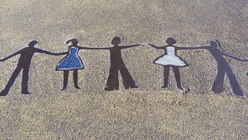
Even if they bicker and cannot get along with each other, they long for the security of the relationship. To plan to separate or get needs met anywhere by either partner is a threat that brings great conflict into the relationship.
How serious the dependency has become is clearly evident when it ends.
Since the relationship has been used to cover up so much personal low self worth, there is disorientation and agony at the end,
Often a great deal of anger is expressed. Because the involvement has been so total, the ending of a relationship will expose the exploitation that has been going on throughout the time the couple has been together.
This kind of dependency is not limited to love relationships.
This kind of dependency can develop in friendships as well.
Dependent relationships can develop between any tow people who seek self worth outside of themselves.
The more self worth they can take from a friend, the more dependent they will be on that friend.
The lower the self worth, the more friends one needs in order to get adequately amounts of their own self worth.
This is not to be confused with the wonderful sharing that goes on between high self worth friends.
Sharing and dependency are two different things.
Here are some signs of Dependency with Lovers or Friends...
1. Initiating most of the phone calls.
2. Initiating most of the times spent together.
3. Wanting to talk about the friendship or the relationship more often than the other.
4. Feelings of anxiety when not with the other person.
5. Uncomfortable during separation times.
6. Concerned or unhappy when the other seems perfectly satisfied and happy when not together.
7. Wanting to know everything the other does, thinks and feels.
8. Carrying a disproportionate responsibility for the relationship.
9. Feeling as thought the other's wants and needs are more important than yours.
10. Feeling as th9ugh you cannot make it on your own if you leave the relationship or friendship.
It is through our own development as whole people that we find our self worth that enables us to then
choose to be in a relationship with someone of mutual high self worth.
Then we can share our worth, rather than use each other.
Personal high self esteem is necessary before one can enter a healthy relationship.
Learning to Love Yourself
Wegscheider-Cruse








 RSS Feed
RSS Feed
